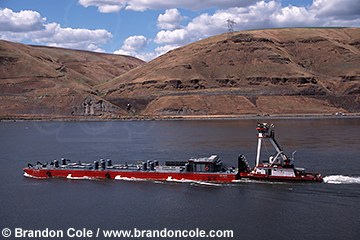forum
library
tutorial
contact

Barges Carry Anglers' Hopes
by Bill LoftusLewiston Tribune, February 8, 1990
|
the film forum library tutorial contact |

|
Barges Carry Anglers' Hopesby Bill LoftusLewiston Tribune, February 8, 1990 |
 Two bright red barges plucked from a crude drydock at the Port of Clarkston carry the hopes of a brighter future for steelhead fishermen.
Two bright red barges plucked from a crude drydock at the Port of Clarkston carry the hopes of a brighter future for steelhead fishermen.
Fisheries officials say the barges will arrive just in the nick of time to help the young fish survive another drought year.
The two barges launched Monday will begin hauling millions of young salmon and steelhead downstream through dams on the Snake and Columbia rivers this spring.
The two barges, 193-feet long by 40-feet wide, cost $2.68 million. The two barges, built by W.A. Strom Contracting of Orofino, were originally scheduled for delivery last March and April.
Bad weather last winter and other construction delays were blamed for setting back the barges' delivery.
In May a wave of young steelhead and salmon arrived at Lower Granite Dam on the Snake west of Clarkston.
The missing barges then meant millions of young fish were released back into the river to find their ways around as many as seven dam turbines. Studies show as many as 15 percent of the young fish die at each dam.
This year's low snowpack in the Snake basin means river levels are likely to be lower than normal this spring when the young fish migrate, said Steve Huffaker at Boise.
Huffaker, Idaho Fish and Game Department Fisheries Bureau chief, said that will make the barges critical for the young fishes' survival.
''What happens, particularly if we don't start getting some snow, is what little flush we get comes all at once. All of the fish arrive at the dam in a short period of time,'' he said.
A water short year also means the water that will be released from dams to help push the fish downstream occurs for only a short time.
Mal Karr, fish passage manager for Columbia Basin tribes at Portland, said early predictions indicate the flush will last only eight to 10 days this year.
Barging the fish downstream shows a definite advantage for young steelhead. The picture is less clear for young chinook, which may fare just as well faring for themselves, Karr added.
The two new barges bring to seven the U.S. Army Corps of Engineers fleet for Operation Fish Run, which began in 1977, said Jim Hackett, a corps spokesman at Walla Walla.
Last year, the corps barged roughly a third of the 20 million young salmon and steelhead believed to migrate from the Snake toward the Pacific.
The corps still has some work to complete on the barges, such as painting the decks and installing wiring, Hackett said.
The new barges will be able to haul 75,000 pounds of fish apiece.
learn more on topics covered in the film
see the video
read the script
learn the songs
discussion forum
